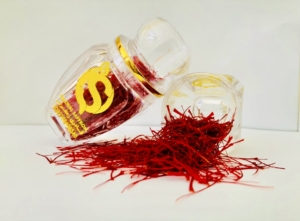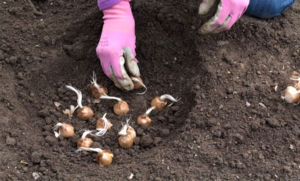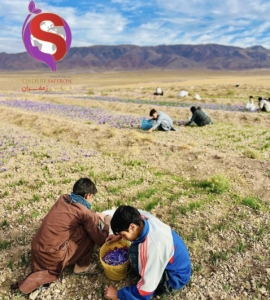Saffron
Saffron:
Saffron with its scientific name (Crocus sativus L) from the family of lilies (Iridaceae) is a perennial and herbaceous plant that flowers in early autumn. Saffron has a round, hard, fleshy and thick underground stem that is covered with brown fibrous shells that farmers It is called onion. But in terms of botany, it is called corm. The number of flowers in each corm is 1 to 4. The flower cover has 3 sepals and 3 petals of the same color Their color is dark lilac or purplish with darker veins and veins in the flower cluster. The actual leaves of saffron are 5 to 11 and usually grow from the ground at the same time as or a little after the flowers. The length of the leaves is 30 40 cm and its width reaches 1.5 to 2 mm. Saffron does not have a real stem and the flowers grow singly or in multiples. The leaves, petals and flowering stem and sometimes the flowers are protected inside a number of membrane sheaths called chlorophyll. The cataphyll membranous sheaths actually consist of 5 to 11 delicate membranous leaves.
Cultivation of saffron:
Saffron is considered a cold resistant plant. The maximum cold that can be imposed for saffron is (-18) degrees Celsius. Since the main part of the saffron plant’s growth, i.e. the flower, develops in the soil. Soil temperature is more important than air temperature for the growth of saffron plant. Because the amount of short-term fluctuations of the soil is less than the air. As a result, the soil gets cold earlier than the air in the fall and warms up later than the air in the spring. Also, the temperature fluctuations on the soil surface are more than the soil depth. Therefore, it is recommended to plant tubers at a depth of 15 cm or more in order to prevent yield reduction and less penetration of light into the soil.
The soil of the saffron farm should have medium texture and more or less soft and permeable. This plant grows well in siliceous, clay, iron and chalk soils.
The saffron soil should have medium texture, relatively deep, free of pebbles and weeds. In the autumn or winter season, while spreading rotted animal manure and plow to a depth of 25 to 30 cm, it is necessary to improve the physical and chemical properties of the soil. The amount of animal manure varies from 30 to 200 tons per hectare.
Saffron is cultivated in parallel rows at a distance of 25 cm from each other and the distance between the corms on each row is 15 to 20 cm and the number of 3 to 15 corms is cultivated in heaps at a depth of 15 to 20 cm. The saffron seed is cultivated from the beginning of September to the middle of October, and considering that the actual sleeping period of the saffron seed is from the middle of May to the middle of July, and also according to the research conducted, the best date for planting the saffron seed is recommended in the month of June, because it causes The yield of saffron increases in the first year. Do not plant corms in the very hot months of the end of July and early August, because at these times the air and ground are very hot, which causes the corms to lose moisture and damage them.
The stages of saffron irrigation based on the water requirement of saffron include four watering times:
The first water – after spreading rotten organic fertilizers and scratching the surface of the ground (carefully and very shallowly so as not to damage the onions), according to the climate of the region, it is done from the end of September to the first decade of November.
The second watering is done one month (4 to 5 weeks) after the first watering and after harvesting the flowers along with the distribution of nitrogen fertilizer in the field.
The third watering is done after weeding the weeds in the field.
Fourth watering – at the end of the growing season before the first decade of April.
The points that must be observed in watering saffron:
• Irrigation of saffron should be shallow and there is no need for very heavy irrigation. Watering should only be done in such a way that the moisture of the water reaches under the roots.
• Before and after planting, irrigation can be useful for saffron, but due to the high probability of infection with mites and fungi, irrigation should be postponed until the month of October.
• In newly cultivated fields, since flowering is not an issue and the main goal is the greening of onions, it is better to repeat the second irrigation after 20 days. After that, if there is no rain, the soil should be kept moist by watering.
• After the onions have fully grown in the first year, watering can be reduced and finished with one irrigation stage in March and one stage in late April.
• The first irrigation in multi-year saffron is when the temperature of the environment cools down and is around 10 degrees Celsius. In this case, the saffron flowers formed in August will be removed from the soil after watering. If the saffron irrigation is done earlier and when the weather has not cooled down, the saffron leaves will turn green first and after a few days the flowers will appear. In this case, the flowers will be of lower quality.
• After the appearance of flowers until the end of flowering, watering should not be done in any way.
Harvesting saffron:
Harvesting saffron includes picking the flower and separating the stigma from other parts of the flower. The life of the flowers is 3 to 4 days and if they are not harvested on time, they will die. And if the flowers are exposed to hot air, wind and sunlight for a long time, the quality of its color and fragrance will decrease and the quality of saffron will decrease. Therefore, the time of harvesting flowers is very important. The flowering period of the saffron farm is usually 15 to 25 days, the amount of flowers increases from the seventh to the tenth day, the harvesting time varies depending on the climatic conditions and the time of the first irrigation, and the collection of flowers is done in the early morning and before sunrise and sometimes in the evening. Usually Chinese flower is done every other day in the first days, and at the peak of flowering every day and sometimes 2 times a day (mornings and evenings).
In order to prevent the flowers from spoiling, it is recommended to use wicker baskets or cotton bags and not to overfill or compress the baskets, and to separate the flowers from the stigmas immediately after picking, because due to the passage of time, the yellow pollen of the flag is placed on the stigmas and Also, the separation of the stigmas is done with difficulty and pressure, which results in damaging the stigmas and reducing the value and marketability of saffron.




